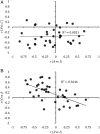Does attractiveness influence condom use intentions in heterosexual men? An experimental study
- PMID: 27315834
- PMCID: PMC4916619
- DOI: 10.1136/bmjopen-2015-010883
Does attractiveness influence condom use intentions in heterosexual men? An experimental study
Abstract
Objectives: Judgements of attractiveness have been shown to influence the character of social interactions. The present study sought to better understand the relationship between perceived attractiveness, perceived sexual health status and condom use intentions in a heterosexual male population.
Setting: The study employed an electronic questionnaire to collect all data, during face-to-face sessions.
Participants: 51 heterosexual, English-speaking men aged between 18 and 69 years.
Outcome measures: Men were asked to rate the attractiveness of 20 women on the basis of facial photographs, to estimate the likelihood that each woman had a sexually transmitted infection (STI) and to indicate their willingness to have sex with or without a condom with each woman.
Results: The more attractive a woman was judged to be on average, the more likely participants would be willing to have sex with her (p<0.0001) and the less likely they were to intend to use a condom during sex (p<0.0001). Multivariate analysis revealed that higher condom use intentions towards a particular woman were associated with lower ratings of her attractiveness (p<0.0005), higher ratings of her STI likelihood (p<0.0001), the participant being in an exclusive relationship (p=0.002), having a less satisfactory sex life (p=0.015), lower age (p=0.001), higher number of sexual partners (p=0.001), higher age at first intercourse (p=0.002), higher rates of condomless sex in the last 12 months (p<0.043) and lower confidence in their ability to assess whether or not a woman had an STI (p=0.001). The more attractive a participant judged himself to be, the more he believed that other men like him would engage in condomless sex (p=0.001) and the less likely he was to intend to use a condom himself (p=0.02).
Conclusions: Male perceptions of attractiveness influence their condom use intentions; such risk biases could profitably be discussed during sex education sessions and in condom use promotion interventions.
Keywords: STIs; condoms; sexual health.
Published by the BMJ Publishing Group Limited. For permission to use (where not already granted under a licence) please go to http://www.bmj.com/company/products-services/rights-and-licensing/
Figures

Similar articles
-
Does attractiveness influence condom use intentions in women who have sex with men?PLoS One. 2019 May 23;14(5):e0217152. doi: 10.1371/journal.pone.0217152. eCollection 2019. PLoS One. 2019. PMID: 31120922 Free PMC article.
-
Age differences in attitudes toward safer sex practices in heterosexual men using an Australian Internet dating service.Sex Health. 2018 Jun;15(3):223-231. doi: 10.1071/SH17074. Sex Health. 2018. PMID: 29262985
-
Reasons for not Using Condoms among Heterosexual Men in Belgrade, Serbia.Acta Dermatovenerol Croat. 2018 Apr;26(1):58-60. Acta Dermatovenerol Croat. 2018. PMID: 29782302
-
Use of the male condom by heterosexual adolescents and young people: literature review.J Adv Nurs. 2007 Jul;59(2):103-10. doi: 10.1111/j.1365-2648.2007.04337.x. J Adv Nurs. 2007. PMID: 17584302 Review.
-
Evidence for behavioural interventions addressing condom use fit and feel issues to improve condom use: a systematic review.Sex Health. 2019 Nov;16(6):539-547. doi: 10.1071/SH19001. Sex Health. 2019. PMID: 31665616
Cited by
-
Does attractiveness influence condom use intentions in women who have sex with men?PLoS One. 2019 May 23;14(5):e0217152. doi: 10.1371/journal.pone.0217152. eCollection 2019. PLoS One. 2019. PMID: 31120922 Free PMC article.
-
Factors affecting condom use among fishers in Elmina fishing community in Ghana.J Public Health Res. 2023 Aug 28;12(3):22799036231191035. doi: 10.1177/22799036231191035. eCollection 2023 Jul. J Public Health Res. 2023. PMID: 37655294 Free PMC article.
-
Are You Safe or Should I Go? How Perceived Trustworthiness and Probability of a Sexual Transmittable Infection Impact Activation of the Salience Network.eNeuro. 2025 Feb 19;12(2):ENEURO.0258-24.2024. doi: 10.1523/ENEURO.0258-24.2024. Print 2025 Feb. eNeuro. 2025. PMID: 39929673 Free PMC article.
-
Delay Discounting and Sexual Decision-Making: Understanding Condom Use Behavior Among U.S. College Students.Arch Sex Behav. 2023 Aug;52(6):2605-2617. doi: 10.1007/s10508-023-02597-4. Epub 2023 Apr 21. Arch Sex Behav. 2023. PMID: 37085661
-
Psychometric evaluation of the Korean version of the sexual communication self-efficacy scale among South Korean college students.Front Public Health. 2025 Mar 31;13:1488982. doi: 10.3389/fpubh.2025.1488982. eCollection 2025. Front Public Health. 2025. PMID: 40231174 Free PMC article.
References
-
- Lorenzo GL, Biesanz JC, Human LJ. What is beautiful is good and more accurately understood. Physical attractiveness and accuracy in first impressions of personality. Psychol Sci 2010;21:1777–82. doi:10.1177/0956797610388048 - DOI - PubMed
-
- Hong DS, Goldstein RB, Rotheram-Borus MJ et al. . Perceived partner serostatus, attribution of responsibility for prevention of HIV transmission, and sexual risk behavior with ‘main’ partner among adults living with HIV. AIDS Educ Prev 2006;18:150–62. doi:10.1521/aeap.2006.18.2.150 - DOI - PubMed
-
- Weeden J, Sabini J. Subjective and objective measures of attractiveness and their relation to sexual behavior and sexual attitudes in university students. Arch Sex Behav 2007;36:79–88. doi:10.1007/s10508-006-9075-x - DOI - PubMed
-
- Hennessy M, Fishbein M, Curtis B et al. . Evaluating the risk and attractiveness of romantic partners when confronted with contradictory cues. AIDS Behav 2007;11:479–90. doi:10.1007/s10461-006-9156-9 - DOI - PMC - PubMed
-
- Nedelec JL, Beaver KM. Physical attractiveness as a phenotypic marker of health: an assessment using a nationally representative sample of American adults. Evol Hum Behav 2014;35:456–63. doi:10.1016/j.evolhumbehav.2014.06.004 - DOI
MeSH terms
LinkOut - more resources
Full Text Sources
Other Literature Sources
